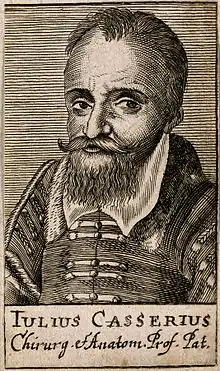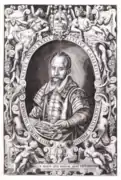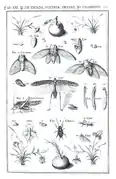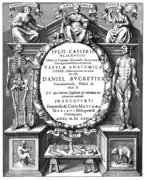Giulio Cesare Casseri
Giulio Cesare Casseri (1552 – 8 March 1616), also written as Giulio Casser, Giulio Casserio of Piacenza or Latinized as Iulius Casserius Placentinus, Giulio Casserio, was an Italian anatomist. He is best known for the books Tabulae anatomicae (1627) and De Vocis Auditusque Organis (c. 1600). He was the first to describe the Circle of Willis.

Biography
Born in Piacenza, he moved to Padua as a young man, when he became a servant to the great anatomist Hieronymus Fabricius. He studied at the School of Medicine of the Universit Artista where his teachers included Girolamo Mercuriale, who was Chair of Clinical Medicine in Padua from 1580-87. Casseri fell out with Fabricius, initially it seems as Fabricius resented the enthusiasm of the students for Casseri's teaching when Fabricius was ill.[1][2][3]
He wrote Tabulae anatomicae, probably the most important anatomical treatise in the seventeenth century, published in Venice, in 1627. The book contained 97 copper-engraved pictures, by Francesco Valesio, inspired by Odiardo Fialetti, Italian painter and former student at Titian's school. The pictures in this book were copied in the works of his successor at Padua, Adriaan van den Spiegel (1578–1625). His De vocis auditusque organis historia anatomica was published in 1600-1 in Ferrara. In this work, he was the first to illustrate the use of tymbals in the production of sound by cicadas.[4] He died in Padua.[1]
The historian of comparative anatomy, F. J. Cole considered Casserius as one of the oldest exponents of comparative anatomy by examining and illustrating anatomical analogues of man in other animals.[5] He described the arterial circle of the brain 37 years before the work of Thomas Willis after whom is named the Circle of Willis.[6][7][8]
 Casserius
Casserius Casseri's illustration of insect sound production
Casseri's illustration of insect sound production Title page of Tabulae anatomicae (1632)
Title page of Tabulae anatomicae (1632)
Related eponyms
- Casser fontanelle (mastoid fontanelle)
- Casser perforated muscle (coracobrachialis muscle)
References
- Riva, Alessandro; Orrù, Beniamino; Pirino, Alessio; Riva, Francesca Testa (2001). "Iulius Casserius (1552-1616): The self-made anatomist of Padua's golden age: Historical Note". The Anatomical Record. 265 (4): 168–175. doi:10.1002/ar.1151.
- Housman, Brian; Bellary, Sharath; Hansra, Simrat; Mortazavi, Martin; Tubbs, R. Shane; Loukas, Marios (2014). "Giulio cesare casseri (c. 1552-1616): The servant who became an anatomist: Giulio Cesare Casseri" (PDF). Clinical Anatomy. 27 (5): 675–680. doi:10.1002/ca.22261.
- de Divitiis, Enrico (2013). "Echoes from the Anatomic Theatre of Padua: Casserius and Fabricius Antagonism". World Neurosurgery. 79 (5): 669–672. doi:10.1016/j.wneu.2012.01.011. ISSN 1878-8750.
- Wessel, Andreas (2013). "Historical Sketch. Casserius and the secret of the cicada's voice". Dtsch. Entomol. Z. 60 (2): 135–146. doi:10.1002/mmnd.201300019.
- Cole, F. J. (1944). A history of comparative anatomy from Aristotle tothe eighteenth century. London: Macmillan.
- Paraskevas, G.; Koutsouflianiotis, K.; Iliou, K.; Noussios, G. (2019). "Iulius Casserius, a relatively underestimated anatomist: his contributions to brain's anatomy". Child's Nervous System. 35 (12): 2243–2248. doi:10.1007/s00381-019-04104-4. ISSN 0256-7040.
- Bender, Matthew; Olivi, Alessandro; Tamargo, Rafael J. (2013). "Iulius Casserius and the First Anatomically Correct Depiction of the Circulus Arteriosus Cerebri (of Willis)". World Neurosurgery. 79 (5–6): 791–797. doi:10.1016/j.wneu.2011.10.044.
- Wysocki, Michał; Saganiak, Karolina; Zwinczewska, Helena; Roy, Joyeeta; Tomaszewski, Krzysztof A.; Walocha, Jerzy A. (2016). "Iulius Casserius: revolutionary anatomist, teacher and pioneer of the sixteenth and seventeenth century". Anatomical Science International. 91 (3): 217–225. doi:10.1007/s12565-016-0326-1. ISSN 1447-6959.
Other sources
- A. Riva, B. Orrù, A. Pirino, F. T. Riva. Iulius Casserius (1552–1616): The self-made anatomist of Padua's golden age. The Anatomical Record, 2001
- Bourgery, J. M. & Jacob, N. H.: Atlas of Human Anatomy and Surgery; Paris, 2005
- Housman, Brian, Bellary, Sharath, Hansra, Simrat, Mortazavi, Martin, Tubbs, R. Shane & Marios Loukas Giulio Cesare Casseri (c. 1552–1616): The servant who became an anatomist. Clinical Anatomy, 2014, Vol.27(5), pp. 675–680
- Weir, Neil, Otolaryngology : an illustrated history. Butterworths, London, 1990.
External links
| Wikimedia Commons has media related to Giulio Cesare Casseri. |